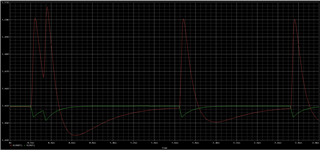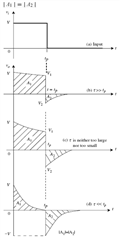Other Parts Discussed in Thread: OPA858
Hi all,
I have been designing an amplifier circuit for an APD signal. This circuit will have an ideal gain of 10M. However, since this APD is sensible to various noise sources, I will apply bandpass filters during the amplification stages. The 1st stage is composed of a transimpedance amplifier (TIA) to convert the APD current to a voltage (V_TIA = I_APD*100k). In this stage, I used a low pass filter with a cut-off frequency of around 1,5MHz. In the 2nd stage, I used an Op Amp with an inverting configuration with a gain of 10. I also added a high pass filter with a cut-off frequency of 530kHz (due to the 300pF capacitor). Here is where the problem happens. At the Op Amp output (red line) appears an overshoot due to this high pass filter. Do you know why I have this problem? How can I fix it? I would like to have this high-pass filter and also reduce the overshoot as much as I can.
I have below the images of the circuit and its simulation results. I also have a zip of the simulation.


Thank you in advance.
Best regards,
João Rego


